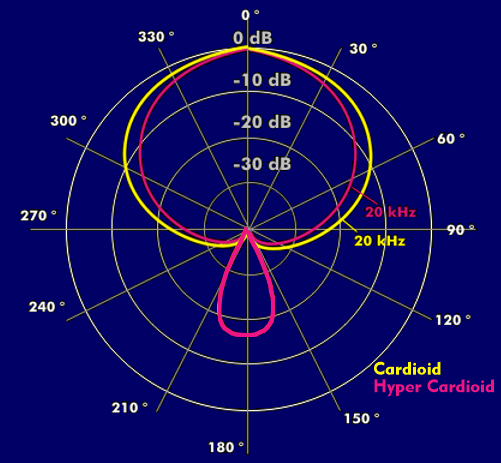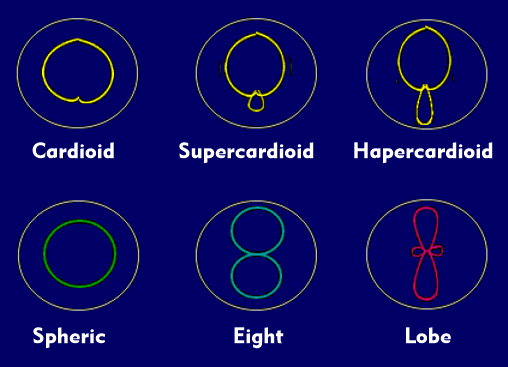polar pattern
Polar pattern is a parameter of microphones. This is the range in which the microphone has a certain sensitivity. It depends on the angle at which the sound hits the microphone.
Representation forms for polar patterns
The directivity is plotted as a line diagram in a polar coordinate system, where the line represents the same sensitivity as a function of the angle of sound incidence. The reference point is at 0 °/360 ° in the polar diagram and has a reference value of 0 dB. An omnidirectional microphone, which picks up sound pressure equally from all directions, has a spherical polar pattern, or omnidirectional for short.
There are several characteristic shapes for the directional pattern, which depend on the design and can be used for specific applications: the cardioid shape with the supercardioid and hypercardioid variants, the spherical shape, figure-of-eight shape, club shape and heart shape (cardioid). There are also microphones with switchable directional characteristics; so-called multipattern microphones.
The directional pattern is frequency-dependent, and sensitivity falls with higher frequencies. From the directional pattern, other parameters can be obtained in addition to the angle of radiation. So the directional factor, the directivity and the directivity. The latter is the ratio between the sound pickup of a microphone with spherical polar pattern and that of another microphone.
Directional microphones have a very pronounced lobe shape and the highest sensitivity on the zero-degree axis.
Cardioid polar pattern is the most commonly used polar pattern in studio applications. There is the classic cardioid, cardioid, supercardioid and hypercardioid. With the cardioid, sound sources in front of the microphone are perceived most strongly, while sound sources located to the side or behind the microphone are perceived only slightly. The directivity factor is about 1.7, and the typical acceptance angle of a cardioid is +/- 65°. This polar pattern is ideal for recording vocals and instruments because background noise is strongly attenuated.
The supercardioid polar pattern is narrower than the cardioid polar pattern. Its acceptance angle is +/- 60°. Even narrower is the hypercardioid, whose acceptance angle is +/- 50°. The various cardioid characteristics are less effective at picking up laterally incident sound sources. The directivity factor is about 2.0. The supercardioid is ideal for picking up individual sound sources.
The omnidirectional characteristic receives sound pressure from all directions with the same sensitivity. All sound sources at the same distance, regardless of their angle to the microphone, are picked up with the same intensity. The degree of focusing is 1. This polar pattern is used for recordings of larger sound sources such as choirs and orchestras, and where the sound sources are spatially distributed. The omnidirectional microphone gets its name from the omnidirectional polar pattern.
With the figure-of-eight characteristic, the directional pattern is mirrored around the microphone axis. Sound sources located in front of and behind the microphone are picked up with the same intensity, while sound sources located to the side are picked up with a strong attenuation. The directional characteristic is used when the sound sources are located in front of and behind the microphone and the lateral sources of interference are to be suppressed.
With the lobe characteristic, sound is picked up primarily from the front and rear. Sound coming in from the side is strongly attenuated. The directional characteristic is frequency-dependent and extremely strongly bundled, the bundling factor is about 3.3.


